

Maritime industry is having its ‘smart’ moment. Everything from ships to land logistics is being swept by the digital wave, with ports being the latest addition. Smart ports are now fast becoming a reality. Does this spell good news? Here’s our take.
Smart ports are here. The combination of Internet of Things (IoT), smart data solutions and high-speed connectivity is ushering in an era of modern ports that promise to leverage the efficiencies derived by the use of these digital technologies.
Port of Hamburg, one of the busiest ports in Europe, is a shining example. It opted for an IoT platform to counter the expected rise in traffic and increasing negative externalities (e.g. traffic congestion, pollution, and road safety) caused by the seaport’s activities. The results have been noteworthy. The port now boasts of everything from smart traffic lights to smart parking to predictive and preventive maintenance capabilities.
And this is only the beginning.
Ulla Tapaninen, Adjunct Professor of maritime logistics and Senior Adviser in charge of Helsinki City maritime cluster programme believes future smart technologies will enable smart transport chains, which in turn will enable more efficient use of resources.
“In future, automated ships will be guided to automated ports. Owners of ships and cargo will know exactly, where their vessels and cargo are at any given time. Ports will form one part of transport chain and can be, for instance integrated, with industrial plants,” Tapaninen envisions.
Smart Marine ecosystem
“The industry is moving to a new age,” says Andrea Morgante, Head of Digital in Wärtsilä Marine Solutions. Wärtsilä has recently fortified its position by acquisitions and is currently launching Digital Acceleration Centres to serve as incubators for new promising ideas by bringing together Wärtsilä’s experts and other stakeholders to develop a new product to be evaluated or piloted by customers.
“Creating a Smart Marine ecosystem will reduce waste by shifting the focus of optimisation from vessels to fleets and entire logistic chain. Data exchange platforms will connect ships and shore through cloud analytics, while technologies like block chain ensure full component traceability. And these are just few examples of the business innovations ahead,” describes Morgante.
“We have long history of utilising IoT and we already have applications, which communicate with the bridge and crew to suggest route and speed-based on historical and real-time data and boundary conditions, like weather,” says Morgante.
“The question is really how to amplify technologies to the next level, creating a platform-based strategy where there is one platform, where all the products can talk to one another and where new services and product features can be easily deployed,” he adds.
Digitalising connections between ship and shore
Project Portify is a case in point. “Portify is a data exchange platform providing dynamic information on the estimated time of arrival and departure from vessel to terminals and updates on berthing slots from terminals to vessel,” says Matteo Natali, Senior Project Manager in charge of project Portify at Wärtsilä, which aims to digitalise ship-to-port interactions.
Natali says the scope of Portify can be extended to a common port-call service platform, where vessel operators can identify, book and pay port services from other players within the port environment, such as bunkering suppliers, logistics providers, tug operators, maintenance companies or authorities.
“Our purpose is to create a smart, connected marine ecosystem,” he explains.
At the moment, most of the information is exchanged with traditional point-to-point connections causing delays and difficulties in planning workload due to unexpected changes in ship calling schedules. “The port value chain is quite long, so impacts from lack of information are multiplied”, he explains.
New smart technologies can improve productivity and environmental sustainability in several ways. “For example, vessels can switch to slow steam if berthing slots change, thus saving fuel, rather than sailing at regular speed and then waiting at anchor,” says Natali.
Wärtsilä is leading this change. “Wärtsilä is the most natural candidate to lead the reshaping of marine industry,” says Natali, “because of several competitive advantages, such as the most comprehensive product portfolio in the market, unique capabilities in data collection and analytics, as well as prediction on ship operations.”
Technological leap
That said, smart technologies are expected to come to maritime industry at different speeds depending on segment, application and regulatory framework. At the moment, most of the solutions offered by digitalisation are still to be invented. Optimising operations that involve many separate agents requires integration and data exchange. According to Tapaninen, the main challenges are safety, reliability and controlling information flow.
Morgante notes that first vessels to go fully digital are small ones, such as short-route ferries. Unmanned large ocean liners are probably not coming up very soon, although digital solutions, such as Wärtsilä’s con-supporting Smart Predict, are already making cruise ships safer.
“Big data and new application of innovative technologies like block chain, monitoring sensors and induction charging will eventually enable smart, fully digitalised ports,” predicts Natali.
A change in mind-set is required, though. Customers have to be willing to share their information. They need to be convinced, that the information they share can be transformed into value for themselves and the whole industry,” concludes Natali.


